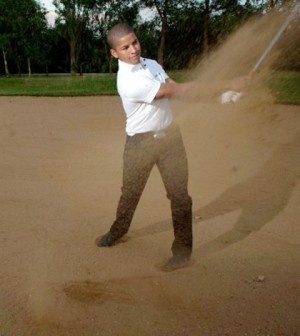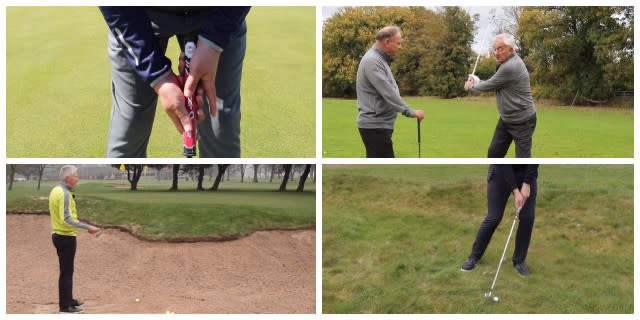Golfers are Clever
 After some of the crazy compensations I have seen in golf swings, I am completely convinced that many golfers are in fact very clever, despite what they may think. Let me explain.
After some of the crazy compensations I have seen in golf swings, I am completely convinced that many golfers are in fact very clever, despite what they may think. Let me explain.
Take the example of the golfer who hangs back on their trail foot and scoops at the golf ball in an attempt to get it airborne. I am sure they have has often heard in lessons that they should finish in balance and with the weight transferred fully onto the lead leg but yet they don’t do it.
Why?
In cases like this, we need to dig a little deeper to understand what is going on. If the golfer has no understanding of HOW the golf ball goes up in the air most effectively, this back foot, scoopy, impact position seems to make a lot of sense. It may not be most consistent, effective or powerful position, but you cannot deny that it makes sense. The golfer has created a logical way to try to get the golf ball up into the air and this pattern will generally stick until a better way is found. Unless the golfer understands WHY they are trying to hit their irons with their weight forward and the grip end leading the club into impact, it is unlikely this change will occur very often.
What about the example of the golfer with the severely open clubface who desperately attempts to swing to the left in an ill-advised attempt to get the golf ball somewhere back towards the target? Although misguided, his swing has been shaped from maybe one ‘off’ piece (the open clubface) which has led to this swing movement to try getting the golf ball to move in a more satisfactory way.
Linking back to my idea of clever golfers, I taught a class of beginner ladies just this past week and for some it was their first time hitting bunker shots. They had some previous ideas of what to do from reading magazine articles and watching golf on the TV but were mainly new to this area of the game.
Between us, we agreed on two facts: 1) we wanted to strike the sand instead of picking the ball cleanly to give best results and some margin for error and 2) we wanted the club to slide through, instead of digging down into the sand. That was it. We then got straight into hitting some shots.
After each few shots I asked for feedback from the golfers and would often hear “it was a good splash of sand but not enough power to get the ball out.” They then made the same set up they had decided was best for a slide rather than a dig, but this time used a bit more speed. Some were then sliding the club through the sand nicely, with enough speed but still not getting the ball out. They decided that they needed to contact nearer to the ball so it took the speed instead of the sand. Others were originally taking too much sand and ‘digging’ down into the ground, but, because they understood what they were trying to achieve, could adjust their shot to work towards the desired outcome. Before very long at all, THAT perfect noise was being heard and golf balls were splashing out onto the green.
Does that all sound too simplistic?
Do you doubt that golfers are as intelligent as I think?
Well, let me explain. I do not think that golfers are able to reach all of their golfing goals on their own. The right coach will help you understand what you are trying to do, make the learning process fun and speed your progress towards your goals. They will help to design the learning environment that allows the golfer to discover 'why' and develop awareness for themselves.
However, make sure, whatever stage of your golf you are at, that you understand what you are trying to do. What you are really trying to do. Extra information in terms of a change in swing plane, or different sequencing of body segments or trying to shift your weight to your lead foot more in the downswing, are all well and good, and often required, but an understanding of WHY you are making that change is what will really help you make the change, progress and achieve your goals.
Related Content:
Andy Griffiths is a UKPGA member, graduated from the University of Birmingham with the AGMS (Applied Golf Management Studies) degree and holds coaching certifications with the PGA, TGA, TPI Levels 1 & 2.
To find out more about Andy follow him on Twitter @andygriffiths1 , visit his website at www.andygriffithsgolf.com or via Facebook facebook.com/andygriffithsgolf
Related Video
Comments
Andy Griffiths
Andy is a UKPGA member & graduate of the AGMS degree at the University of Birmingham. He's coached in more than 30 countries and travelled and worked with many of the best in the business. His no. 1 desire is to help golfers reach their dreams, and to enjoy the process!
Latest Articles




















